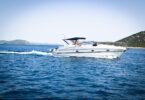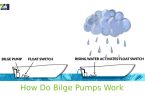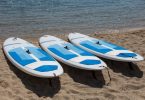The size of a trolling motor battery is essential to benefit from its operative function alongside your boat optimally. A lot of factors come into consideration before determining the battery size to purchase. Do you have enough space for these batteries? Are they the best of batteries for your trolling motor? The wrong size of battery means you would be out of power to run your trolling motor which translates to been stranded. The wrong type of battery translates to reducing the life span of the battery, and inefficiency during your use of the trolling motor.
Table of Contents
What You Should Know About Trolling Motors
Two batteries power trolling motors; the first (starter battery) powers the ignition system of the boat, and the second (deep cycle battery) powers all functions of the trolling boat. There exist another type of battery referred to as the dual-purpose battery; it can perform both the ignition and power functions of the trolling motor at the same time as a single battery.
Starter Battery
Starter better (or engine cranking) batteries are built to deliver high current in short bursts. Due to this inherent feature, they have a large surface area of lead plates with thinner and more lead plates. Check in the owner’s manual for the specification of Amp battery required to power your boat; it is specified in the manual as Marine Cranking AMP (MCA). Most regular boats can use any battery, but sophisticated ones must be handled according to their specifications. The starter battery replenishes its power while the boat runs.
Deep Cycle Battery
The deep cycle powers all the boat accessories alongside the trolling motor; it is designed to deliver power over a long time at a slower rate. Owing to this feature, its lead plates are designed to be bigger and fewer. If you are purchasing a deep cycle battery, the Reserve Capacity is as important as the MCA of a starter battery. The reserve capacity rating helps you know how much load it can power for how long before discharging. The higher the RC rating, the longer it would be able to serve your boat.
Common Categories of Battery to Source From
There are many categories of batteries, but not all would serve your boat or trolling motor optimally. The categories of batteries discussed below are the choicest to source from for your boat and trolling motor. They each differ in their capacities, Pros, and Cons.
AGM Batteries
AGMrefers to Absorbent Glass Matting battery which is the makeup of this battery. This battery is tightly sealed, which translates to its ability to hold charges over a long time. The system of glass fibres used to maintain the charge in the battery increases the surface area for the electrolytes. This battery doesn’t use fluid to contain its electrolyte so, it is lighter than a wet-celled battery. It is also less prone to vibration, spill-proofed, and has a longer life span. This battery doesn’t require much maintenance and could serve you for at least four years.
Wet Cell Battery
This battery is perhaps the most common to boat owners. Wet cell batteries are the oldest and cheapest of all the categories discussed in this article. The wet cell battery is the typical Lead-acid battery which uses fluid (sulphuric acid and distilled water) to contain its electrolytes. This battery can serve for a long number of years (say three years) but requires high maintenance. It is susceptible to damage by vibration, and spillage because of its vented design. Wet cell batteries have a system to prevent overcharging; if you can top up distilled water regularly, the chances of overcharging are low.
GEL Batteries
Gel batteries like AGM are recent technology improvements. They both require little maintenance, well-sealed, and are less prone to vibration damage. GEL batteries are the most expensive category of batteries. They function unaffected by low temperatures and discharge slowly (less than 1% monthly). This battery is ideal for people who slack on maintenance; they could serve for as long as five years. GEL batteries use silica fumes alongside sulphuric acid to form a gel that contains it electrolytes longer.
Best Batteries for Your Trolling Motor
It is a fact that deep cycle batteries are the best for trolling motors. Nevertheless, the capacity of the deep cell battery is as important as the battery itself. Capacity translates to how long it can power the trolling motor on water. We calculate this by dividing the Ampere hour of the deep cell battery by the draw power of the trolling motor. The higher the Ampere hour (Ah) of the battery the longer it would be able to serve. The draw power of the trolling motor is measured as the amount of power consumed at maximum speed. Take for example a trolling motor has a draw power of 15amps at maximum speed and your battery is 100Ah dividing them through equals 6.7 hours on water. The draw power of the trolling motor is indicated as the motor average draw in the manual of the trolling motor. Also consider the volt of your battery and the size of your boat before purchase. A bigger boat would need a bigger voltage battery to function effectively.
Battery Size for Trolling Motor
Battery size in this context translates to how much power a battery can hold and deliver. Standardly in metric units following the law of thumbs a trolling motor of 75 pounds thrust (Comparable to 746W or 1hp). Every 200 pounds of your boats total weight would require 5 pounds of thrust. Trolling motor batteries usually come in 12volts, 24 volts, and 36 volts. A 12 volts battery, for example, consumes almost 720W of power and is suitable for boats less than 16 feet’s.
Important Tips
Haven done all that’s necessary to purchase the best battery for your trolling motor you must stick to these tips to ensure maintenance of your battery.
- Periodically check for corrosion on your battery and clean them off with baking soda and toothpaste. Corrosion disturbs the output capacity of your battery
- Use the same type of battery if you use more than one type to power your trolling motor. A connection of different types of battery is a threat to the life span of the batteries involved.
- Check the battery after use, if it needs to be charged please charge the battery immediately.
- To conserve the power of your battery store in a dark place, and connect it to a trickle charger.
These are routine maintenance and precaution tips a battery can never do by itself no matter how it is built to be maintenance-free. It is therefore important for the boat owner to make this routine checks.








Leave a Comment